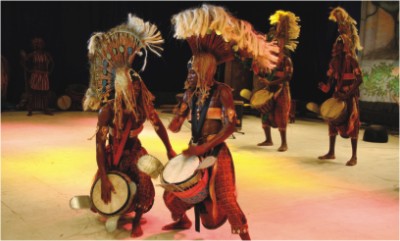Rhythm & Sound
Djembe
Nazia Ahmed

African music has been a major factor in the shaping of what we know today as blues and jazz. These styles have all borrowed from African rhythms and sounds, brought over the Atlantic Ocean by slaves.
As the rise of rock'n'roll music is often credited as having begun with 1940s blues music, and with so many genres having branched off from rock - the myriad subgenres of heavy metal, punk rock, pop music and many more - it can be argued that African music has been at the root of a very significant portion of all contemporary music.
A djembe is a skin covered hand drum, shaped like a large goblet, and meant to be played with bare hands. According to the Bamana people in Mali, the name of the djembe comes directly from the saying "Anke dje, anke be" which literally translates to "everyone gather together", and defines the drum's purpose. It is a member of the membranophone family of musical instruments: a frame or shell (in the djembe's case it is a shell) covered by a membrane or drumhead made of one of many products, usually rawhide. The djembe also has metal rings, rope, and skin.
The djembe originated in West Africa, and is an integral part of the region's musical tradition and culture. The djembe is now popular all over the world.
The djembe is a drum, found in all of West Africa, where it is one of the most common instruments.
Djembe drums are tuned by evenly pulling the vertical ropes very tightly so that a system of metal rings brings the skin down over the drum shell. These verticals are tightened all the way around, perhaps taking multiple passes, and using a lever of some sort. The next step is to use more rope to put in horizontal "twists" of the vertical ropes.
The djembe is said to contain three spirits: the spirit of the tree, the spirit of the animal of which the drum head is made, and the spirit of the instrument maker.
The djembe plays a key role in modern music that needs a highly percussive rhythm section. It has been used by such artists as Ben Harper, Paul Simon, Grateful Dead, Bedouin Soundclash, Incubus' Brandon Boyd, Gruvis Malt, Brian Rosenworcel of Guster, Dispatch and Micheal Cross, of bands such as Some State and The Swamp Monsters. The djembe is very popular in drum circles, and in many circles is the primary instrument, most likely for its easily portable size, wide range of sounds, and its distinct tones.
Learning to play the djembe generally involves finding a master drummer and having a couple of private lessons or lessons for small groups of people. Players generally need no less than 2 months to achieve a meaningful sound and no less than 2 years to achieve a sound that is at least comparable to master drummers'.
Sources Internet
| 